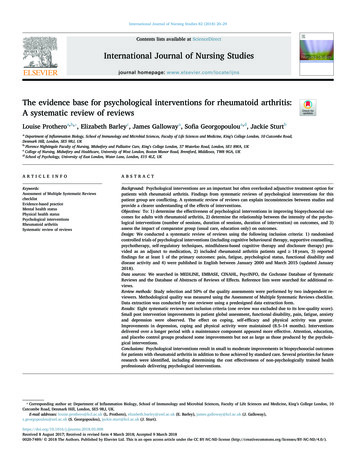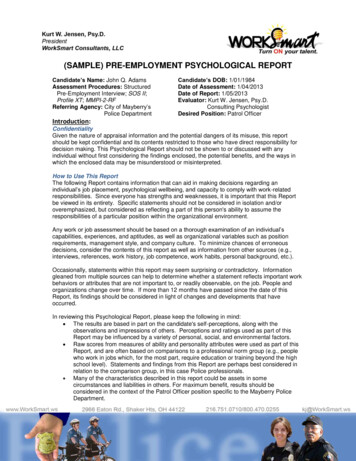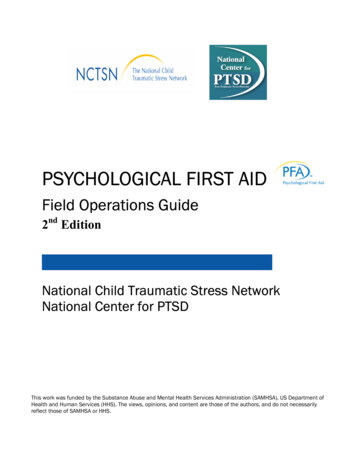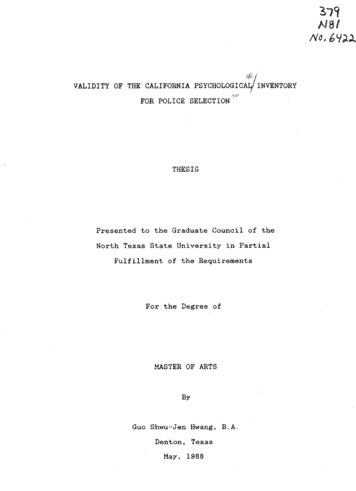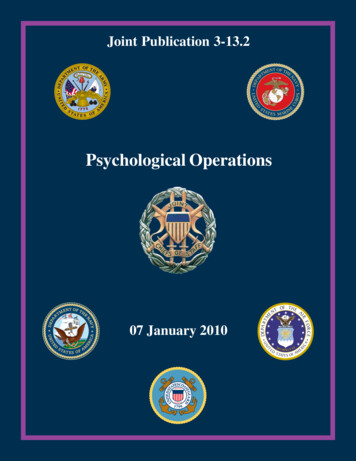
Transcription
Joint Publication 3-13.2Psychological Operations07 January 2010
PREFACE1.ScopeThis publication provides guidance for the planning, execution, and assessment ofpsychological operations in support of joint, multinational, and interagency activitiesacross the range of military operations.2.PurposeThis publication has been prepared under the direction of the Chairman of the JointChiefs of Staff (CJCS). It sets forth joint doctrine to govern the activities andperformance of the Armed Forces of the United States in joint operations and providesthe doctrinal basis for interagency coordination and for US military involvement inmultinational operations. It provides military guidance for the exercise of authority bycombatant commanders and other joint force commanders (JFCs) and prescribes jointdoctrine for operations, education, and training. It provides military guidance for use bythe Armed Forces in preparing their appropriate plans. It is not the intent of thispublication to restrict the authority of the JFC from organizing the force and executingthe mission in a manner the JFC deems most appropriate to ensure unity of effort in theaccomplishment of the overall objective.3.Applicationa. Joint doctrine established in this publication applies to the Joint Staff,commanders of combatant commands, subunified commands, joint task forces,subordinate components of these commands, and the Services.b. The guidance in this publication is authoritative; as such, this doctrine will befollowed except when, in the judgment of the commander, exceptional circumstancesdictate otherwise. If conflicts arise between the contents of this publication and thecontents of Service publications, this publication will take precedence unless the CJCS,normally in coordination with the other members of the Joint Chiefs of Staff, hasprovided more current and specific guidance. Commanders of forces operating as part ofa multinational (alliance or coalition) military command should follow multinationaldoctrine and procedures ratified by the United States. For doctrine and procedures notratified by the United States, commanders should evaluate and follow the multinationalcommand’s doctrine and procedures, where applicable and consistent with US law,regulations, and doctrine.For the Chairman of the Joint Chiefs of Staff:LLOYD J. AUSTIN IIILieutenant General, USADirector, Joint Staffi
PrefaceIntentionally BlankiiJP 3-13.2
SUMMARY OF CHANGESREVISION OF JOINT PUBLICATION 3-13.2DATED 11 SEPTEMBER 2009 Clarified the role of psychological operations (PSYOP) in relation toinformation operations, public affairs, strategic communication, andirregular warfare Emphasized specific missions performed by joint PSYOP forces Provided key considerations for effective joint PSYOP Explained the role of US Special Operations Command and US Joint ForcesCommand as it relates to exercising combatant command (commandauthority) over PSYOP forces Enhanced the discussion for the requirement to establish a jointpsychological operations task force Redefined the term “propaganda” to clarify employment by the adversary Introduced the concepts of civil authority information support and militaryinformation support Clarified the legal authorities for the conduct of psychological operations Clarified the approval process for PSYOP programs and the process fordelegation of product approval and dissemination Clarified how PSYOP support the special operations core tasks Identified the lettering change in the Joint Operation Planning andExecution System, Volume II, as it pertains to the PSYOP tab Improved Appendix A, “Capabilities,” to better explain Service capabilitiesto support achievement of US national objectives by using organic assets forproduction and dissemination of PYSOP productsiii
Summary of ChangesIntentionally BlankivJP 3-13.2
TABLE OF CONTENTSPAGEEXECUTIVE SUMMARY . viiCHAPTER IOVERVIEW General .I-1 Legal Framework and Authorities.I-3 Levels of War .I-4 Purpose .I-5 Missions.I-5 Key Considerations for Effective Joint Psychological Operations .I-6CHAPTER IIROLES, RESPONSIBILITIES, AND RELATIONSHIPS General . II-1 Roles and Responsibilities . II-1 Relationships . II-9CHAPTER IIICOMMAND AND CONTROL General . III-1 Organizing Psychological Operations Forces . III-3CHAPTER IVPLANNING Joint Operation Planning and Phasing . IV-1 Planning Considerations . IV-5 Guidance . IV-11 Support of Irregular Warfare . IV-12CHAPTER VJOINT PSYCHOLOGICAL OPERATIONS PROCESS General . V-1 Planning: Phase I . V-1 Target Audience Analysis: Phase II . V-3 Series Development: Phase III . V-4 Product Development and Design: Phase IV . V-4 Approval: Phase V . V-5 Production, Distribution, and Dissemination: Phase VI . V-5 Evaluation: Phase VII. V-6v
Table of ContentsCHAPTER VIEMPLOYMENT Support to Unified Action . VI-1 Psychological Operations and the Range of Military Operations . VI-1 Psychological Operations and Special Operations Activities . VI-2 Interagency Coordination . VI-5 Multinational Operations. VI-6 Psychological Operations Support to Civil Authorities within the United Statesand its Territories. VI-6CHAPTER VIIENABLERS Intelligence Operations .VII-1 Communications System .VII-3 Logistics .VII-4APPENDIXA Capabilities . A-1B Considerations for Tab A, (Psychological Operations) to Appendix 3,(Information Operations) to Annex C, (Operations) .B-1C References .C-1D Administrative Instructions. D-1GLOSSARYPart I Abbreviations and Acronyms .GL-1Part II Terms and Definitions .GL-5FIGUREII-1IV-1IV-2V-1V-2VI-1VII-1viDepartment of Defense Information Activities . II-10Examples of Joint Military Psychological Operations Across the Rangeof Military Operations . IV-8Specific Psychological Operations Guidance and PlanningConsiderations . IV-10Key Components of a Psychological Operations Program . V-3Phase I Activities. V-4Special Operations Supported by Psychological Operations . VI-2Psychological Operations Logistics Requirements .VII-5JP 3-13.2
EXECUTIVE SUMMARYCOMMANDER’S OVERVIEW Provide an Overview of Psychological Operations Discuss Roles, Responsibilities, and Relationships Discuss the Command and Control of Psychological Operations Discuss Planning for Psychological Operations Discuss the Joint Psychological Operations Process Discuss Psychological Operations Employment Discuss Psychological Operations Enablers Provide Reference on Psychological Operations Capabilities Provide Reference for the Psychological Operations Tab to Operation PlansOverviewThe need to consistentlyintegrate all instruments ofnational power hasincreased.In today’s complex and rapidly evolving informationenvironments, the need to integrate all instruments ofnational power has taken on increased relevance tosustain operational success.In the operationalenvironment, effective influence is gained byconsistency between what we say and do, and how wellwe understand and respond to our audience.Department of Defense(DOD) is a key componentof United StatesGovernment (USG)communications strategy.Within the military and informational instruments ofnational power, the Department of Defense (DOD) is akey component of a broader United States Government(USG) communications strategy. To be effective, allDOD communications efforts must inherently supportthe credibility, veracity, and legitimacy of USGactivities.Purpose of psychologicaloperations (PSYOP).The specific purpose of psychological operations(PSYOP) is to influence foreign audience perceptionsand subsequent behavior as part of approved programsin support of USG policy and military objectives.PSYOP professionals follow a deliberate process thataligns commander’s objectives with an analysis of thevii
Executive Summaryenvironment; select relevant target audiences (TAs);develop focused, culturally, and environmentally attunedmessages and actions; employ sophisticated mediadelivery means and produce observable, measurablebehavioral responses.PSYOP is employed acrossthe range of militaryoperations.PSYOP forces operate across the range of militaryoperations. PSYOP that are continuously planned andassessed contribute significantly to the success of bothpeacetime engagements and major operations. PSYOPare governed by explicit legal authorities that direct anddetermine how the capability is utilized.Policy governs DODPSYOP.Policy makers develop realistic and relevant policies thatare within the capabilities of PSYOP to support. DODpolicy, for instance, addresses the intent of theorganization, guides decisionmaking, and promptsaction to integrate PSYOP into military operations andother USG strategies.National strategies providekey guidance.The Chairman of the Joint Chiefs of Staff and thecombatant commanders (CCDRs) refer to nationalstrategies as they establish guidance that provides thenecessary strategic direction for employment of PSYOP.Joint PSYOP span alllevels of war.Joint PSYOP activities span all levels of war andsupport policy and commanders’ objectives fromstrategic to tactical levels. When conducted at thestrategic level, PSYOP are designed to support USGdepartments and agencies, geographic combatantcommands, or multinational partners. PSYOP activitiesconducted at the operational level generally support theimplementation of regional policies and military plans.Tactical PSYOP activities normally are conducted insupport of local military or civil authorities.PSYOP is employed as aforce multiplier.In conflict, PSYOP as a force multiplier can degrade theenemy’s relative combat power, reduce civilianinterference, minimize collateral damage and maximizethe local populace’s support for operations.PSYOP require sustainedapplication across allphases of an operation.Early planning and employment of PSYOP forces willmaximize the potential to influence foreign audienceswithin the area of interest. PSYOP require sustainedapplication, as part of a broader USG communicationstrategy. PSYOP are a critical component in all phasesviiiJP 3-13.2
Executive Summaryand in some phases may be the joint force commander’s(JFC) main effort.PSYOP are synchronizedwith all other forceactivities.The synchronization of PSYOP with all other actions ofthe US and multinational forces precludes messages oractions at one level from contradicting or weakening theeffectiveness at another.PSYOP incorporatesindigenous resources.To maximize TA receptivity to PSYOP, planning shouldincorporate the use of indigenous resources, keycommunicators, and dissemination platforms as soon asoperationally feasible.Criteria to assess PSYOPeffectiveness must beestablished.Quantifiable and timely assessment criteria to determinemeasures of effectiveness (MOEs) are required for everyPSYOP campaign.Roles, Responsibilities, and RelationshipsPlanning guidance forcombatant commanders.The Unified Command Plan and Joint StrategicCapabilities Plan (JSCP) provide direction and guidanceto CCDRs concerning joint operation planning and theirrespective responsibilities.PSYOP are part of DOD’sinformation activities.DOD information activities include informationoperations (IO), PSYOP (as a core capability of IO),public affairs (PA) (to include visual information), anddefense support to public diplomacy (DSPD).PSYOP support strategiccommunication.Strategic communication (SC) integrates variousinstruments of national power with other activitiesacross the USG to synchronize crucial themes,messages, images, and actions. PSYOP are the keycapability that supports SC by influencing foreignaudiences in support of US objectives.PSYOPare a corecapability of informationoperations (IO).IO is the integrated employment of the core capabilitiesof electronic warfare (EW), computer networkoperations (CNO), PSYOP, military deception(MILDEC), and operations security (OPSEC), inconcert with supporting and related capabilities toinfluence, disrupt, corrupt, or usurp adversarial humanand automated decisionmaking while protecting ourown.As a core capability of IO, PSYOP play acentral role in the achievement of the JFC’sinformation objectives through its ability to induce orix
Executive Summaryreinforce adversary attitudes and behavior favorable tothese objectives.The IO cell chief.In order to ensure all aspects of IO are properlyintegrated and synchronized into the combatantcommand planning process, an IO cell chief is chosen.This cell chief convenes meetings of the IO cellperiodically in order to facilitate the integration of core,supporting, and related capabilities. Within the IO cell,the PSYOP representative integrates, coordinates,deconflicts, and synchronizes the use of PSYOP withother IO capabilities.PSYOP are supported bycomputer networkoperations.CNO support PSYOP with dissemination assets toinclude interactive Internet activities. CNO activitiescan deny or degrade an adversary’s ability to access,report, and process information.PSYOP support militarydeception.PSYOP create and reinforce MILDEC actions that areexecuted to deliberately mislead adversary militarydecisionmakers about US military capabilities,intentions, and operations. MILDEC operations thatintegrate PSYOP targeting provide the JFC with theability to influence the adversary to take specific actions(or inactions) giving the joint force the advantage.PSYOP actions areprotected with securityprecautions.It is essential that PSYOP plans and messages areprotected prior to execution through the proper use ofinformation security, information assurance, physicalsecurity, and OPSEC.Electronic warfare supportPSYOP.EW platforms provide a means of disseminating PSYOPmessages and shaping the information environmentthrough the electronic dissemination of PSYOPproducts. EW validates the assessment of PSYOPeffectiveness by providing information on threatresponses to broadcasts.Public affairs and PSYOP,although are discreteefforts, support each other.PA and PSYOP activities are separate and distinct, butthey must support and reinforce each other, whichrequires coordination, synchronization, and occasionallydeconfliction.JFCs must ensure that appropriatecoordination between PSYOP and PA activities areconsistent with the DOD Principles of Information,policy or statutory limitation, and security.xJP 3-13.2
Executive SummaryCommand And ControlUS Special OperationsCommand and US JointForces Command.In accordance with Secretary of Defense (SecDef) andForces for Unified Commands Assignment Tables,Commander, United States Special OperationsCommand (CDRUSSOCOM) exercises combatantcommand (command authority) (COCOM) over allActive Component PSYOP forces. Commander, USJoint Forces Command (CDRUSJFCOM) exercisesCOCOM over all assigned Reserve Component (RC)PSYOP forces once they are activated. When directedby SecDef, the CDRUSSOCOM or CDRUSJFCOMtransfers PSYOP forces to geographic combatantcommanders (GCCs).When these forces aretransferred, the command relationship of the gainingcommander (and the losing commander will relinquish)over those forces must be specified; in most cases thatwill be operational control (OPCON).PSYOP planning iscentralized.Commanders centralize PSYOP planningcombatant command due to its importancecommander’s strategic concept.When aestablishes a subordinate joint force theyPSYOP staff positions on the JFC’s staff.Organization of PSYOPforces.The requested PSYOP force size and planneddisposition may exceed the command and controlcapabilities of the joint force components. In thesecases the CCDR may identify the requirement toestablish a joint psychological operations task force(JPOTF) or psychological operations task force (POTF)as a component of the joint force. PSYOP forces maybe organized as a JPOTF or a PSYOP support element(PSE). The JFC may delegate OPCON of all PSYOPforces to the JPOTF or may exercise OPCON ofspecified PSYOP forces through the units orcomponents to which they are assigned.The joint psychologicaloperations task force.The JPOTF is responsible for providing PSYOP supportto joint or multinational operations at the tactical andoperational levels. The JPOTF is also responsible fordeconflicting all PSYOP that occur under the joint taskforce and other commands as designated by theestablishing authority.at theto theCCDRincludexi
Executive SummaryCentralized planning anddirection and decentralizedexecution are the referredmethodologies.If the JFC determines that PSYOP planning andexecution requires control by a component commandwith that mission as its sole purpose, then the JFCrequests establishment of a JPOTF, POTF, or PSE.Control should favor centralized planning and directionand decentralized execution. Control is exercised fromthe lowest level that accomplishes the requiredcoordination. Considerations for PSYOP may dictatethat control be at high national levels.Early identification ofPSYOP requirements bythe supported combatantcommander is essential.The entire US military PSYOP capability is available foremployment by the supported GCC. Operations mayrequire use of RC PSYOP forces. Early identification ofPSYOP requirements through the Global ForceManagement Board is necessary to facilitate RCactivation, processing, and training. The high demandfor PSYOP forces to support worldwide operationsmake reachback a critical component for PSYOPsuccess.Planning“Guidance forEmployment of the Force”and the Joint StrategicCapabilities Plan set neartime priorities.Guidance for Employment of the Force and the JSCP setpriorities for activities undertaken in the near term –usually the period covered by budget execution (presentthrough two years). These plans define how a GCC willconduct all DOD activities within their area ofresponsibility.PSYOP can havesignificant impacts onachieving objectives.Joint planning integrates US military actions with otherinstruments of national power and multinational partnersto achieve specified end states. CCDRs translatenational and theater strategy into strategic andoperational concepts through the development ofsecurity cooperation strategies and implementationplans, and operation and campaign plans. PSYOP havesignificant impact on the JFC objectives as they involvethe need to mobilize the civilian population, whilesimultaneously isolating the adversary, taking away itsability to muster popular support.Phasing the operation.Phasing helps JFCs and staffs to visualize and thinkthrough the entire operation or campaign and to definerequirements in terms of forces, resources, time, space,and purpose.xiiJP 3-13.2
Executive SummaryPSYOP are based onobjectives, and arecoordinated andsynchronized.To plan for the effective employment of PSYOP, JFCsand their staffs must possess a thorough knowledge ofnational security policy and objectives, as well asnational and theater military objectives. They mustensure PSYOP planning is consistent with IO, PA, andDSPD planning as well as overall USG objectives. Inaddition, they must ensure all PSYOP activities areclosely coordinated and synchronized to ensure thatconsistent themes and messages are communicated toTAs.Combatant commandersidentify and requestPSYOP support needed.CCDRs clearly articulate PSYOP support requirementsin terms of the required capabilities. CCDRs submitrequests for PSYOP forces to the Joint Staff. The JointStaff is responsible for validating PSYOP force requestsand will assign either US Special Operations Command(USSOCOM) or US Joint Forces Command as the JointForce Provider, depending on the activity, type of forcesnecessary, and availability.PSYOP offer SecDef options for engagement thatPSYOP can be a forcemultiplier, enhancing other potentially avoid the employment of additional combatelements of national power. forces, reduce the period of confrontation, and enhancethe diplomatic, informational, military, and economicinstruments of national power.PSYOP are important tothe shape and deter phasesof an operational plan.CCDR activities executed during the shape phase assistin determining the character of future operations.During the deter phase, PSYOP provides powerfuloperational leverage in support of flexible deterrentoptions. PSYOP forces can be employed to gatherinformation, undermine a potential opponent’s will orcapacity to wage war, and enhance the capabilities ofmultinational forces.DOD PSYOP issynchronized andcoordinated with otherUSG agencies.Coordination of DOD PSYOP with other USG agenciesfacilitates the communication of the objectives of eachorganization and synchronization of effort. The jointinteragency coordination group at the combatantcommand headquarters is an interagency staff group thatestablishes regular, timely, and collaborative workingrelationships between civilian and military operationalplanners.Department of State’s (DOS’s) Bureau of InternationalInformation Programs engages audiences on issues ofxiii
Executive Summaryforeign policy, society, and values to help create anenvironment receptive to US national interests. Inaddition to DOS, PSYOP should be coordinated withother USG agencies, including, but not limited to, theCentral Intelligence Agency; International BroadcastingBureau; Broadcasting Board of Governors; Departmentsof Commerce, Homeland Security, Transportation,Energy, and Justice; Drug Enforcement Administration;and the US Coast Guard. When PSYOP are plannedduring multinational operations, planners mustcoordinate with multinational partners to ensure theattainment of US and multinational security objectives.Irregular warfare (IW) is defined as a violent struggleamong state and non-state actors for legitimacy andinfluence over the relevant populations. Ultimately, IWis a political struggle for control or influence over, andthe support of, a relevant population. When PSYOPoccur in IW, their role usually is much greater thanduring major operations and campaigns.PSYOP in irregularwarfare.Conducting IW focuses on two approaches – direct andindirect. The direct approach addresses the requirementto pursue adversaries, and their infrastructure andresources. PSYOP are key supporting operations to eachcontextual application of indirect approaches toexecuting IW. The ideological and political factorsassociated with IW create a fertile field forpsychological operations.Joint Psychological Operations ProcessThe joint PSYOP processhas seven phases.xivThe joint PSYOP process is a standard framework bywhich PSYOP assets and critical enablers plan, execute,and evaluate PSYOP with proficiency and consistencythroughout major campaigns, operations, and peacetimeengagements. The joint PSYOP process consists ofseven phases: planning; target audience analysis (TAA);series development; product development and design;approval; production, distribution, dissemination; andevaluation. Each of these phases is designed to apply toany type or level of operation. Collectively, the phasesaddress important considerations and include thenecessary activities for the proper integration of PSYOPwith the CCDR’s military strategy and mission.JP 3-13.2
Executive SummaryCombatant commandersneed approval to executePSYOP.CCDRs are required to obtain approval prior toconducting PSYOP. A PSYOP program provides therequired SecDef guidance for PSYOP execution.PSYOP objectives, usually determined by the highestlevel PSYOP element involved in the operation (e.g.,CCDR), provide the framework for developing thePSYOP plan.PSYOP are integral to thecommander’s vision andconcept of operations.The goal of PSYOP planning is to integrate PSYOP intothe commander’s vision and concept of operations.Staff planners adjust the PSYOP plan as necessary tosupport the commander’s objectives.Target audience analysis(TAA).The information learned as a result of TAA is used inthe development of PSYOP products, actions, or series.Series are reviewed for their suitability, length orduration, potential to affect the intended audience,accuracy of persuasive arguments or techniques toinfluence behavior change, and the resources availableto execute them.Evaluate the targetaudience’s reaction.The work completed during the planning, analysis, andseries development phases are vital for designing theprototypes of PSYOP products. Evaluating the TA’sunderstanding and acceptance of the argumentsconveyed in a PSYOP product is a key task. Pretestingproducts also helps establish a foundation forconducting post testing of entire series afterdissemination occurs.Effective approvalprocesses are needed.A judicious and efficient approval process for PSYOPseries and the management of the series developmentand approval process are fundamental in providingsupporting PSYOP to emerging, ongoing, and futureoperations.Determine the mostappropriate disseminationmeans through TAA.Once production is complete, products are transferred tothe disseminating unit or agency in accordance with apredetermined timeline.The most appropriatedissemination means are determined through TAA, andintelligence about the operational area.PSYOP messages also are communicated throughFace-to-facecommunication is effective. preplanned face-to-face contact with the localpopulace. Repeated face-to-face communication withlocal leaders, key communicators, and citizens is thexv
Executive Summarymost effective technique to support the commander’smission.Assess PSYOP effects.Assessing the effects of PSYOP series on TAs relies onPSYOP impact indicators and analyses produced inearlier phases. PSYOP assessment criteria are focusedon the achievement of supporting PSYOP objectives byTAs. The results of the evaluation are thus two-fold asthey:(1) Yield substantive information about the trendstoward achieving the supporting PSYOP objectives.(2) Contribute data that are relevant for thecommander’s overall MOEs.EmploymentIntegrate PSYOP withsupported organizationplanning and decisionmaking.PSYOP are integrated in joint and multinational militaryoperations as well as actions conducted by otherdesignated governmental agencies. To be effective,PSYOP must be fully integrated with the supportedorganization’s planning and decision-making activities.PSYOP, a key capability innon-domestic activities,may be used domesticallyto support lead federalagencies.PSYOP are a key capability in furthering US
psychological operations in support of joint, multinational, and interagency activities across the range of military operations. 2. Purpose . This publication has been prepared under the direction of the Chairman of the Joint Chiefs of Staff (CJCS). It sets forth joint doctrine to govern the



